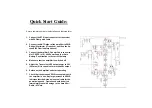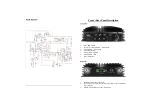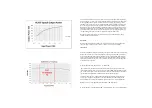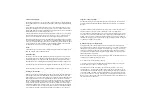
Antenna Considerations:
The KL503 is designed to work into a 50 ohms resistive load and any antenna outside of
this requirement must use an antenna tuning unit between the output of the amplifier and
antenna.
It is recommended to check that the antenna to be used is sufficiently rated for at least
500W power handling before connecting this product. It is also recommended to check
that the VSWR does not change considerably with increased power as this would indicate
that the antenna was not suitable for high power use.
Cable losses particularly increase with increasing frequency. Always use a good quality
50 Ohm feeder and keep the length as short as possible. Not only will this allow more
power to reach the antenna but will also increase the signal strength at the receiver.
This amplifier should not be operated into mismatched loads, (high VSWR), An accepta-
ble level should be less than 1.5:1. Less than 2.0:1 is possible but some reduction in pow-
er may be seen and the amplifier will work less efficiently and generate more heat. There
is no protection for excessive VSWR so it is advised that the antenna is tuned correctly
for the frequency it is to used on to avoid damage to the amplifier.
Mode:
The KL503 may be used for all of the common narrow band transmission modes such as
SSB, CW,AM,FM, SSTV and data modes etc.
RX Preamplifier:
The KL503 is fitted with an RX preamplifier, that when activated can help to increase
the received signal level. This can be used when the signal level is low to help improve
intelligibility of the received signal. The RX preamp can be used independently of the
amplifier however when the amplifier and preamp are both activated the preamp is auto-
matically switched out of line when the amplifier is in transmission. Switch
\
is used to
switch the preamp on and off. LED
_
is illuminated when the preamp is switched on.
Warning: Transmit Time.
Hi Duty cycle modes such as FM and Data modes etc. operate the amplifier at full power
all of the time unlike modes like SSB and CW that are either intermittent or only reach
peak output for very short times, these high duty cycle modes will run the amplifier much
harder and generate more heat in the same amount of time. It should be noted that the
amplifier although capable of being used with these modes should not be operated contin-
uously. A transmission time of more than a few minutes should be avoided to avoid ex-
cessive transistor junction temperature. The exact time for transmission in these modes
will depend on numerous factors such as, how good the ventilation around the amplifier
is if there is sufficient space for freely flowing air to circulate, etc. If the ambient temper-
ature is high this will reduce the total time in transmission. Common sense should be
Input drive and power output:
The amplifier should give full output with approximately 4-5W input. Excessive input
power should be avoided and the amplifier should always be operated in a responsible
manner.
The KL503 features an input attenuator
a
that may be used to reduce the output of the
amplifier if the drive radio does not have the facility to reduce its output power.
The input attenuator should NOT however be used to reduce the input power level of the
drive radio if it is greater than 6W! Otherwise the attenuator may be damaged from over-
heating. There are 6 levels of input attenuation and position 6 is direct input, with no at-
tenuation. So setting to position 1 will provide the lowest output power from the amplifi-
er, and position 6 the maximum output.
Maximum output power considerations:
All amplifiers have a maximum output and this occurs shortly after gain compression
where by Pin no longer produces a proportionate increase in power output . The amplifier
should always be operated at a point below its saturated output. Trying to extract every
last watt by overdriving the amplifier will not actually help your signal to be stronger,
you will in fact cause higher levels of distortion which will make your signal less intelli-
gible at the distant receiver station.
Running the amplifier a little under max output will also allow the amplifier to run cooler
and make it more reliable for many years of use.
As an example consider the following situation.
1 ‘S’ point on a receiver is usually approximately calibrated at 6dB so for example the
difference between S5 and S7 2 ‘S’ points is 12dB.
The difference between 5W and 250W is about 17dB a big increase to your signal
strength, almost 3 ‘S’ points, with the same antenna. Now lets say for example you run
the amplifier at a moderate 200W output by slightly reducing the input power, the differ-
ence between 250W and 200W is less than 1dB which when you compare this to 6 dB
per S point is actually very little and as the amplifier is not running at its absolute maxi-
mum will give a cleaner output with less distortion that will actually make a difference at
the distant receiver for the better!!
























